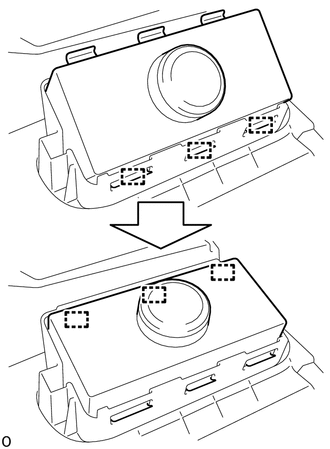Toyota Yaris: Front Passenger Airbag Assembly / Installation
INSTALLATION
PROCEDURE
1. INSTALL INSTRUMENT PANEL PASSENGER WITHOUT DOOR AIRBAG ASSEMBLY
| (a) Engage the hooks. |
|
(b) Push in the instrument panel passenger without door airbag assembly to engage the hooks to the instrument panel sub-assembly.
(c) Install the 2 screws.
2. INSTALL NO. 2 INSTRUMENT PANEL WIRE
(a) Connect the airbag connector of the No. 2 instrument panel wire to the instrument panel passenger without door airbag assembly.
NOTICE:
When connecting any airbag connector, take care not to damage the airbag wire harness.
HINT:
Refer to How to Connect or Disconnect Airbag Connector:
Click here

(b) Engage the clamp.
3. INSTALL INSTRUMENT PANEL SUB-ASSEMBLY
Click here

 Removal
Removal
REMOVAL CAUTION / NOTICE / HINT The necessary procedures (adjustment, calibration, initialization, or registration) that must be performed after parts are removed, installed, or replaced during the instrument panel passenger without door airbag assembly removal/installation are shown below...
Other information:
Toyota Yaris XP210 (2020-2025) Reapir and Service Manual: Engine Stop and Start ECU Communication Stop Mode
DESCRIPTION Detection Item Symptom Trouble Area Engine Stop and Start ECU Communication Stop Mode Communication stop for "Stop and Go/Start" is indicated on the "Communication Bus Check" screen of the GTS. Click here Engine stop and start ECU branch line or connector Power source circuit of engine stop and start ECU Engine stop and start ECU ground circuit Engine stop and start ECU WIRING DIAGRAM CAUTION / NOTICE / HINT CAUTION: When performing the confirmation driving pattern, obey all speed limits and traffic laws...
Toyota Yaris XP210 (2020-2025) Reapir and Service Manual: Power Integration No.1 System Internal Failure (B235204)
DESCRIPTION This DTC is output when the semiconductor power integration ECU detects a Internal circuit error. DTC No. Detection Item DTC Detection Condition Trouble Area B235204 Power Integration No.1 System Internal Failure Microcomputer abnormality AD circuit trouble Semiconductor power integration ECU WIRING DIAGRAM Click here CAUTION / NOTICE / HINT NOTICE: When using the GTS with the ignition switch off to troubleshoot: Connect the GTS to the vehicle, and turn a courtesy switch on and off at 1...
Categories
- Manuals Home
- Toyota Yaris Owners Manual
- Toyota Yaris Service Manual
- Headlights
- G16e-gts (engine Mechanical)
- Engine & Hybrid System
- New on site
- Most important about car
Break-In Period
No special break-in is necessary, but a few precautions in the first 600 miles (1,000 km) may add to the performance, economy, and life of the vehicle.
Do not race the engine. Do not maintain one constant speed, either slow or fast, for a long period of time. Do not drive constantly at full-throttle or high engine rpm for extended periods of time. Avoid unnecessary hard stops. Avoid full-throttle starts.

